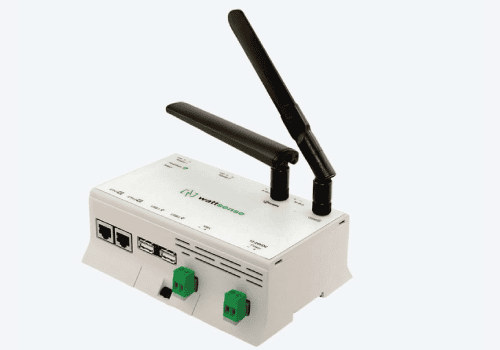As smart buildings grow in complexity, the role of IoT (Internet of Things) gateways becomes increasingly essential. An IoT gateway serves as the central hub connecting IoT devices, such as sensors and actuators, to the cloud, enabling efficient data transmission, security, and control throughout a building.
What Is a Smart IoT Gateway?
What Is a Smart IoT Gateway?
IoT gateways connect various IoT devices and sensors to cloud-based data processing. This centralised hub allows for seamless communication between devices, often facilitating bidirectional data flow – this means that data can travel both from devices to the cloud and from the cloud back to the devices. They operate with low power consumption to save energy and in doing so, communicate through short-range wireless transmission (but can also be connected using long-range transmission like Wi-Fi). Modern smart gateways perform edge processing, reducing data congestion by filtering and processing information locally before sending it to the cloud.
IoT gateways are crucial in optimising the performance of connected devices and ensuring smooth operations in environments like smart buildings. Without a gateway, IoT devices might struggle with communication due to differences in protocols, security challenges, or data overloads. Gateways act as translators, ensuring that devices can "speak" with each other and the cloud.
Where to Place an IoT Gateway
Where to Place an IoT Gateway
The placement of your IoT gateway significantly affects its performance and the overall connectivity of your IoT network. In urban environments, gateways are best placed on tall buildings or structures to overcome obstacles like dense traffic and physical barriers. In industrial or smart building contexts, gateways should be located close to key IoT devices, such as energy management systems, to ensure low-latency communication and reliable data transmission.
Security in IoT Gateways
Security in IoT Gateways
One of the primary advantages of IoT gateways is their ability to enhance security. These devices encrypt and authenticate data transmitted between IoT devices and the cloud, preventing unauthorised access or data breaches. In essence, they act as the first line of defense, protecting sensitive information from cyber threats.
Edge Computing Capabilities
Edge Computing Capabilities
A significant feature of many IoT gateways is their edge computing capabilities. Edge computing allows for processing data locally, reducing the load on cloud infrastructure and minimising latency. This is particularly important for real-time applications in smart buildings, where immediate responses are crucial—such as in security systems or energy management solutions.
For example, the medium local Wattsense Bridge IoT Gateway allows you to create your own building management control system and integrate and manage all LoRaWAN enabled smart energy meters in one place.
The FieldServer BACnet provides visibility and control of any network, from anywhere, any time. This gateway also comes with a choice of Wi-Fi integration for cloud connectivity.
Both products are aimed at creating smart, future-proof building management systems but differ in focus. The Wattsense Bridge emphasises ease of use and protocol unification, while the FieldServer BACnet gateway traditionally focuses more on protocol conversion and system integration.
In smart building environments, IoT gateways are indispensable. They not only facilitate seamless communication between devices and the cloud but also improve security and optimise data flow through edge processing. For anyone implementing smart technologies, IoT gateways provide the necessary infrastructure to ensure your devices work together efficiently and securely.
Investing in a reliable IoT gateway can drastically enhance the performance of your smart building, making it more secure, responsive, and scalable for future technologies.











